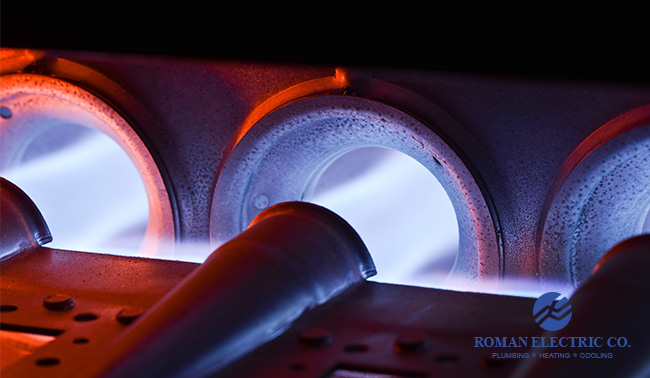If you’re unfamiliar with the parts of a furnace, the whole system can seem like a great, mysterious beast: unapproachable and only giving off heat intermittently. Your furnace doesn’t have to be an enigma to you! The experts at Roman Electric can help you understand your heating system, part by part. Here’s a simple guide to your furnace:
Do You Have a Gas Furnace or an Electric Furnace?
It can be especially difficult to navigate your furnace if you’re not even sure what type you have. We can help with that! There are certain attributes on your HVAC system that can tell you if you have a gas or electric furnace.
How to Know If You Have a Gas Furnace
A gas furnace has a pipe coming out of the top of it that connects to the wall or the ceiling. This is the exhaust system, the tell-tale sign. The pipe could either be about three to six inches and made up sheet metal or about two to four inches and white.
How to Know if You Have an Electric Furnace
Unlike a gas furnace, an electric furnace does not need an exhaust system. In an electric furnace, there will be a fan on the side and a ductwork system at the top.
A Simple Guide to Your Gas Furnace
There are three major parts to a gas furnace:
Gas Burner
You’ve probably heard of a “pilot flame,” the little fire that burns in a gas furnace that helps heat your home. The gas burner is where the pilot flame is located! The gas burner heats up the air in the heat exchanger (which you’ll read about soon).
Gas Manifold
The gas manifold is a part that connects your gas burner to your gas valve, which adjusts the gas pressure needed to keep the pilot flame burning.
Heat Exchanger
A heat exchanger is the heart and soul of your gas furnace. It’s made up of coils and tubes and works to produce heat through an exchange process, hence the name!
A Simple Guide to Your Electric Furnace
The three most important parts of an electrical furnace include:
Contactor
Similar to the heat exchanger in the gas furnace, the contactor is the part of your electric furnace that conducts voltage to your heating element. The contactor is powered by the thermostat, so once your home reaches the desired temperature, the thermostat will tell the contactor to stop heating your home.
Sequencer
The sequencer turns the heating elements in your electric furnace on or off. It’s the part that keeps the electric current from spiking.
Transformer
The transformer powers your electric furnace. It transfers electrical energy between circuits.
Call Roman Electric
Navigating your furnace doesn’t have to be difficult, but trying to repair it yourself can be. The licensed HVAC technicians at Roman Electric can repair your furnace, gas or electric, so that it’s warmed up and ready for the late fall and winter seasons. Call one of our friendly representatives at (414) 771-5400 to schedule an appointment with us today.

